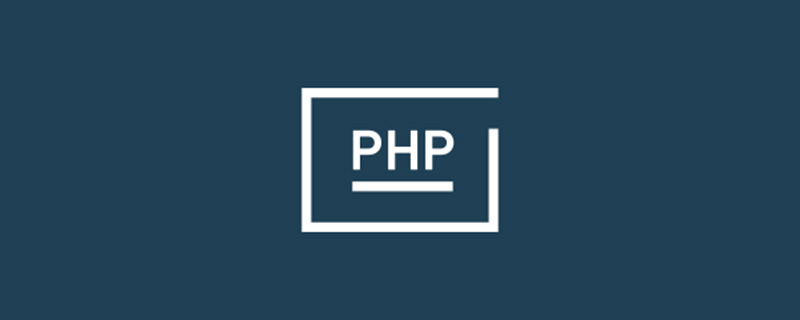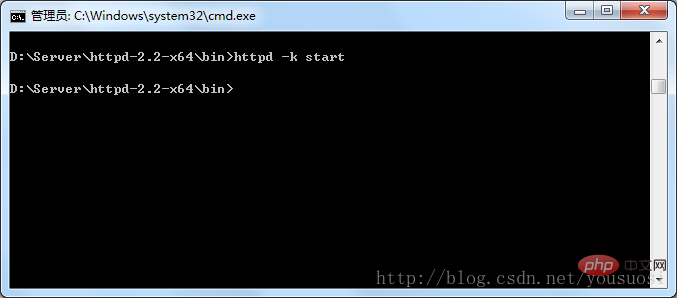How to install PHP environment under 64-bit Win7
Win7 64-bit installation method of PHP environment: first create a new folder Server in the root directory of drive D; then modify the default listening port of Apache; then modify the default website root directory and default domain name; finally in Execute the command "httpd -k start" in the command line window to start the Apache service.

Recommended: "PHP Video Tutorial"
[Software Download]
The installation file used in this installation example is as shown in the figure:

##64 version of MySQL The installation file mysql-5.5.33-winx64.msi can be downloaded directly from the official website, download address: http://dev.mysql.com/downloads/mirror.php?id=414045
The installation and configuration of 64-bit PHP environment is not much different from that of 32-bit. The installation of Apache requires manual installation and configuration because there is no direct installation file. [Preparation or precautions before installation]1. Installing Apache requires administrator status. If you are not logged in as an administrator, please refer to Baidu. 2. The default listening port of Apache and IIS are both 80, which conflicts. If IIS is installed on your machine, you need to modify the default port of IIS. How to modify it, please also refer to Baidu. [Apache installation and basic configuration]Manual installation of Apache feels simpler than fool-proof installation. If it is installed in the root directory of the C drive, directly unzip the installation compressed package. Put it in the root directory of C drive and it will be OK. However, generally when we install, we put Apache and PHP on other disks. In this example, they are installed in D:\Server. The installed directory structure is as shown in the figure:



Use Notepad to open the file D:\Server/httpd-2.2-x64\conf\httpd.conf and modify line 172, as shown in the figure:

If you want to modify Apache's default listening port, 80 here also needs to be modified.
4. Modify the permissions of the default website directory
Open the file D:\Server/httpd-2.2-x64\conf\httpd.conf with Notepad and modify line 193

3. Start - cmd, open the cmd window, and execute the command in the directory D:\Server\httpd-2.2-x64\bin:
Httpd –k install , the results are as follows:

Execute the command httpd /? to view the help, where you can find commands such as installation, uninstallation, startup, restart, and stop.
4. Execute the command httpd –k start in the command line window to start the Apache service, as shown in the figure:

5. Enter in the browser http://localhost, as shown in the figure:

[ApacheCommon configuration]
# The basic configuration of ##Apache mainly includes: changing the website root directory and modifying the default file. For details, please refer to my blog 32 Installation and configuration under Win7PHPEnvironment (1), here we only briefly describe the basic operations.
1. Change the website root directory
1. Create a new folder in the D:\Server folderWeb;
2, Use Notepad to open the file D:\Server/httpd-2.2-x64\conf\httpd.conf and modify lines 179 and 206 , as shown in the figure:


Modify the default fileModify the
240line, as shown in the figure:
The above is the detailed content of How to install PHP environment under 64-bit Win7. For more information, please follow other related articles on the PHP Chinese website!

Hot AI Tools

Undresser.AI Undress
AI-powered app for creating realistic nude photos

AI Clothes Remover
Online AI tool for removing clothes from photos.

Undress AI Tool
Undress images for free

Clothoff.io
AI clothes remover

Video Face Swap
Swap faces in any video effortlessly with our completely free AI face swap tool!

Hot Article

Hot Tools

Notepad++7.3.1
Easy-to-use and free code editor

SublimeText3 Chinese version
Chinese version, very easy to use

Zend Studio 13.0.1
Powerful PHP integrated development environment

Dreamweaver CS6
Visual web development tools

SublimeText3 Mac version
God-level code editing software (SublimeText3)

Hot Topics
 1386
1386
 52
52
 PHP 8.4 Installation and Upgrade guide for Ubuntu and Debian
Dec 24, 2024 pm 04:42 PM
PHP 8.4 Installation and Upgrade guide for Ubuntu and Debian
Dec 24, 2024 pm 04:42 PM
PHP 8.4 brings several new features, security improvements, and performance improvements with healthy amounts of feature deprecations and removals. This guide explains how to install PHP 8.4 or upgrade to PHP 8.4 on Ubuntu, Debian, or their derivati
 How To Set Up Visual Studio Code (VS Code) for PHP Development
Dec 20, 2024 am 11:31 AM
How To Set Up Visual Studio Code (VS Code) for PHP Development
Dec 20, 2024 am 11:31 AM
Visual Studio Code, also known as VS Code, is a free source code editor — or integrated development environment (IDE) — available for all major operating systems. With a large collection of extensions for many programming languages, VS Code can be c
 7 PHP Functions I Regret I Didn't Know Before
Nov 13, 2024 am 09:42 AM
7 PHP Functions I Regret I Didn't Know Before
Nov 13, 2024 am 09:42 AM
If you are an experienced PHP developer, you might have the feeling that you’ve been there and done that already.You have developed a significant number of applications, debugged millions of lines of code, and tweaked a bunch of scripts to achieve op
 Explain JSON Web Tokens (JWT) and their use case in PHP APIs.
Apr 05, 2025 am 12:04 AM
Explain JSON Web Tokens (JWT) and their use case in PHP APIs.
Apr 05, 2025 am 12:04 AM
JWT is an open standard based on JSON, used to securely transmit information between parties, mainly for identity authentication and information exchange. 1. JWT consists of three parts: Header, Payload and Signature. 2. The working principle of JWT includes three steps: generating JWT, verifying JWT and parsing Payload. 3. When using JWT for authentication in PHP, JWT can be generated and verified, and user role and permission information can be included in advanced usage. 4. Common errors include signature verification failure, token expiration, and payload oversized. Debugging skills include using debugging tools and logging. 5. Performance optimization and best practices include using appropriate signature algorithms, setting validity periods reasonably,
 How do you parse and process HTML/XML in PHP?
Feb 07, 2025 am 11:57 AM
How do you parse and process HTML/XML in PHP?
Feb 07, 2025 am 11:57 AM
This tutorial demonstrates how to efficiently process XML documents using PHP. XML (eXtensible Markup Language) is a versatile text-based markup language designed for both human readability and machine parsing. It's commonly used for data storage an
 PHP Program to Count Vowels in a String
Feb 07, 2025 pm 12:12 PM
PHP Program to Count Vowels in a String
Feb 07, 2025 pm 12:12 PM
A string is a sequence of characters, including letters, numbers, and symbols. This tutorial will learn how to calculate the number of vowels in a given string in PHP using different methods. The vowels in English are a, e, i, o, u, and they can be uppercase or lowercase. What is a vowel? Vowels are alphabetic characters that represent a specific pronunciation. There are five vowels in English, including uppercase and lowercase: a, e, i, o, u Example 1 Input: String = "Tutorialspoint" Output: 6 explain The vowels in the string "Tutorialspoint" are u, o, i, a, o, i. There are 6 yuan in total
 Explain late static binding in PHP (static::).
Apr 03, 2025 am 12:04 AM
Explain late static binding in PHP (static::).
Apr 03, 2025 am 12:04 AM
Static binding (static::) implements late static binding (LSB) in PHP, allowing calling classes to be referenced in static contexts rather than defining classes. 1) The parsing process is performed at runtime, 2) Look up the call class in the inheritance relationship, 3) It may bring performance overhead.
 What are PHP magic methods (__construct, __destruct, __call, __get, __set, etc.) and provide use cases?
Apr 03, 2025 am 12:03 AM
What are PHP magic methods (__construct, __destruct, __call, __get, __set, etc.) and provide use cases?
Apr 03, 2025 am 12:03 AM
What are the magic methods of PHP? PHP's magic methods include: 1.\_\_construct, used to initialize objects; 2.\_\_destruct, used to clean up resources; 3.\_\_call, handle non-existent method calls; 4.\_\_get, implement dynamic attribute access; 5.\_\_set, implement dynamic attribute settings. These methods are automatically called in certain situations, improving code flexibility and efficiency.




